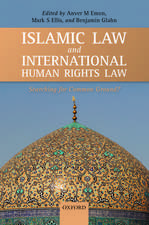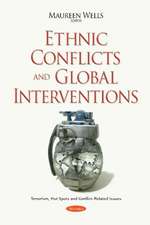The Responsibility to Protect: Ending Mass Atrocity Crimes Once and For All
Autor Gareth Evansen Limba Engleză Paperback – 4 sep 2009
"Never again!" the world has vowed time and again since the Holocaust. Yet genocide, ethnic cleansing, and other mass atrocity crimes continue to shock our consciences—from the killing fields of Cambodia to the machetes of Rwanda to the agony of Darfur.
Gareth Evans has grappled with these issues firsthand. As Australian foreign minister, he was a key broker of the United Nations peace plan for Cambodia. As president of the International Crisis Group, he now works on the prevention and resolution of scores of conflicts and crises worldwide. The primary architect of and leading authority on the Responsibility to Protect ("R2P"), he shows here how this new international norm can once and for all prevent a return to the killing fields.
The Responsibility to Protect captures a simple and powerful idea. The primary responsibility for protecting its own people from mass atrocity crimes lies with the state itself. State sovereignty implies responsibility, not a license to kill. But when a state is unwilling or unable to halt or avert such crimes, the wider international community then has a collective responsibility to take whatever action is necessary. R2P emphasizes preventive action above all. That includes assistance for states struggling to contain potential crises and for effective rebuilding after a crisis or conflict to tackle its underlying causes. R2P's primary tools are persuasion and support, not military or other coercion. But sometimes it is right to fight: faced with another Rwanda, the world cannot just stand by.
R2P was unanimously adopted by the UN General Assembly at the 2005 World Summit. But many misunderstandings persist about its scope and limits. And much remains to be done to solidify political support and to build institutional capacity. Evans shows, compellingly, how big a break R2P represents from the past, and how, with its acceptance in principle and effective application in practice, the promise of "Never again!" can at last become a reality.
Gareth Evans has grappled with these issues firsthand. As Australian foreign minister, he was a key broker of the United Nations peace plan for Cambodia. As president of the International Crisis Group, he now works on the prevention and resolution of scores of conflicts and crises worldwide. The primary architect of and leading authority on the Responsibility to Protect ("R2P"), he shows here how this new international norm can once and for all prevent a return to the killing fields.
The Responsibility to Protect captures a simple and powerful idea. The primary responsibility for protecting its own people from mass atrocity crimes lies with the state itself. State sovereignty implies responsibility, not a license to kill. But when a state is unwilling or unable to halt or avert such crimes, the wider international community then has a collective responsibility to take whatever action is necessary. R2P emphasizes preventive action above all. That includes assistance for states struggling to contain potential crises and for effective rebuilding after a crisis or conflict to tackle its underlying causes. R2P's primary tools are persuasion and support, not military or other coercion. But sometimes it is right to fight: faced with another Rwanda, the world cannot just stand by.
R2P was unanimously adopted by the UN General Assembly at the 2005 World Summit. But many misunderstandings persist about its scope and limits. And much remains to be done to solidify political support and to build institutional capacity. Evans shows, compellingly, how big a break R2P represents from the past, and how, with its acceptance in principle and effective application in practice, the promise of "Never again!" can at last become a reality.
Preț: 249.91 lei
Nou
Puncte Express: 375
Preț estimativ în valută:
47.82€ • 49.61$ • 39.88£
47.82€ • 49.61$ • 39.88£
Carte tipărită la comandă
Livrare economică 27 martie-10 aprilie
Preluare comenzi: 021 569.72.76
Specificații
ISBN-13: 9780815703341
ISBN-10: 0815703341
Pagini: 349
Dimensiuni: 152 x 229 x 25 mm
Greutate: 0.5 kg
Editura: Brookings Institution Press
Colecția Brookings Institution Press
ISBN-10: 0815703341
Pagini: 349
Dimensiuni: 152 x 229 x 25 mm
Greutate: 0.5 kg
Editura: Brookings Institution Press
Colecția Brookings Institution Press
Notă biografică
Gareth Evans has been president and CEO of the International Crisis Group since 2000 and was foreign minister of Australia from 1988 to1996. Co-chair of the International Commission on Intervention and State Sovereignty (2000–01), which initiated the Responsibility to Protect concept, he has since led the movement for its worldwide adoption and application. Evans has served on many other global bodies including the UN Secretary-General's High-Level Panel on Threats, Challenges, and Change (2003–04) and the UN Secretary-General's Advisory Committee on the Prevention of Genocide and Mass Atrocities (2006–present), and was named in 2008 to co-chair the International Commission on Nuclear Non-Proliferation and Disarmament. His numerous publications include eight other books and a prizewinning Foreign Policy article on cooperative security. Mail & Guardian (South Africa)
Descriere
"Never again!" the world has vowed time and again since the Holocaust. Yet genocide, ethnic cleansing, and other mass atrocity crimes continue to shock our consciences—from the killing fields of Cambodia to the machetes of Rwanda to the agony of Darfur.
Gareth Evans has grappled with these issues firsthand. As Australian foreign minister, he was a key broker of the United Nations peace plan for Cambodia. As president of the International Crisis Group, he now works on the prevention and resolution of scores of conflicts and crises worldwide. The primary architect of and leading authority on the Responsibility to Protect ("R2P"), he shows here how this new international norm can once and for all prevent a return to the killing fields.
The Responsibility to Protect captures a simple and powerful idea. The primary responsibility for protecting its own people from mass atrocity crimes lies with the state itself. State sovereignty implies responsibility, not a license to kill. But when a state is unwilling or unable to halt or avert such crimes, the wider international community then has a collective responsibility to take whatever action is necessary. R2P emphasizes preventive action above all. That includes assistance for states struggling to contain potential crises and for effective rebuilding after a crisis or conflict to tackle its underlying causes. R2P's primary tools are persuasion and support, not military or other coercion. But sometimes it is right to fight: faced with another Rwanda, the world cannot just stand by.
R2P was unanimously adopted by the UN General Assembly at the 2005 World Summit. But many misunderstandings persist about its scope and limits. And much remains to be done to solidify political support and to build institutional capacity. Evans shows, compellingly, how big a break R2P represents from the past, and how, with its acceptance in principle and effective application in practice, the promise of "Never
Gareth Evans has grappled with these issues firsthand. As Australian foreign minister, he was a key broker of the United Nations peace plan for Cambodia. As president of the International Crisis Group, he now works on the prevention and resolution of scores of conflicts and crises worldwide. The primary architect of and leading authority on the Responsibility to Protect ("R2P"), he shows here how this new international norm can once and for all prevent a return to the killing fields.
The Responsibility to Protect captures a simple and powerful idea. The primary responsibility for protecting its own people from mass atrocity crimes lies with the state itself. State sovereignty implies responsibility, not a license to kill. But when a state is unwilling or unable to halt or avert such crimes, the wider international community then has a collective responsibility to take whatever action is necessary. R2P emphasizes preventive action above all. That includes assistance for states struggling to contain potential crises and for effective rebuilding after a crisis or conflict to tackle its underlying causes. R2P's primary tools are persuasion and support, not military or other coercion. But sometimes it is right to fight: faced with another Rwanda, the world cannot just stand by.
R2P was unanimously adopted by the UN General Assembly at the 2005 World Summit. But many misunderstandings persist about its scope and limits. And much remains to be done to solidify political support and to build institutional capacity. Evans shows, compellingly, how big a break R2P represents from the past, and how, with its acceptance in principle and effective application in practice, the promise of "Never










